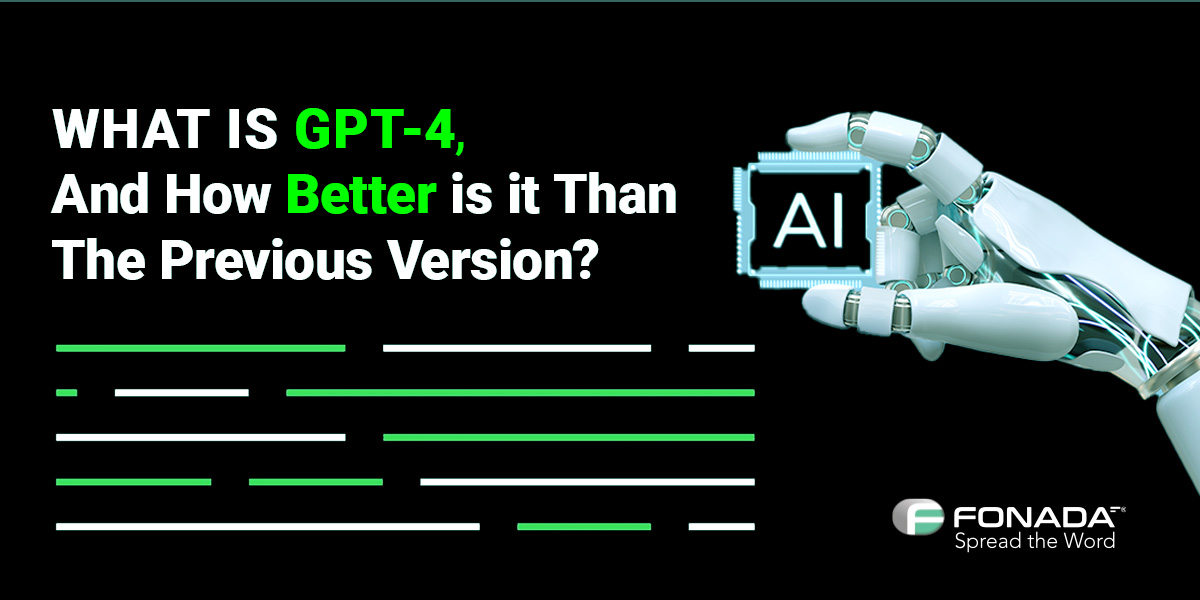Introduction:
Artificial intelligence (AI) has become a global phenomenon in recent months. Despite its creative and beneficial nature, research suggests the ethical consequences of the technology’s capabilities. GPT refers to “Generative Pre-trained Transformer.” After introducing the first GPT-1 model in 2018, the GPT-series models have progressed dramatically to become more sophisticated.
GPT-4 is also the first GPT model to be a large multimodal model. This means that it can accept both images and text. OpenAI has made a chatbot that is smarter and more advanced. It takes deep learning and machine learning to the next level. The latest version of ChatGPT can “demonstrate human-level performance on a variety of professional and academic benchmarks,” but it will additionally accept text and image inputs. It is accessible to ChatGPT Plus users.
Read More: Google Introduces “Bard” As A Rival To ChatGPT AI
What is GPT-4 ?
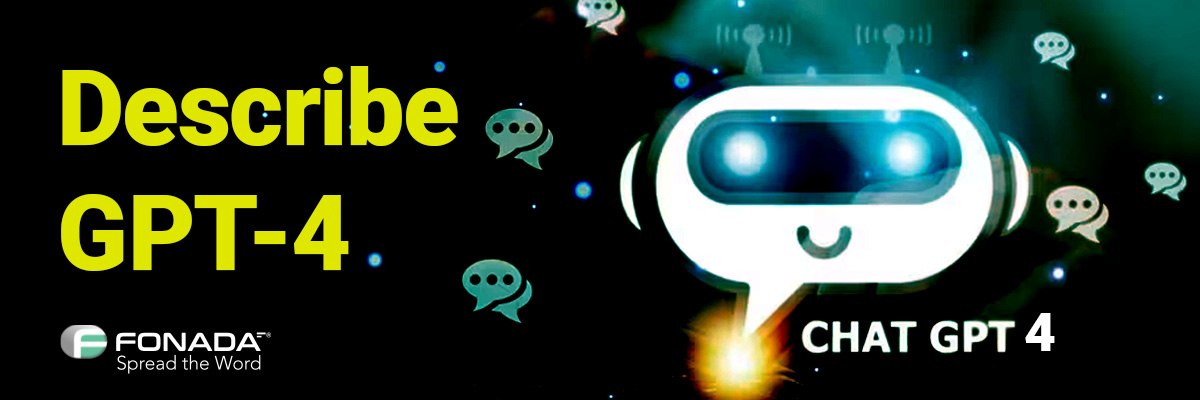
GPT is the abbreviation of Generative Pre-trained Transformer. This neural network interprets data and generates replies using machine learning; it is most obviously the language model underlying the successful chatbot ChatGPT.
The latest iteration, GPT-4, is the driving force under various applications, such as OpenAI’s premium ChatGPT Plus and Microsoft’s hybrid Bing chatbot/search engine.
OpenAI’s multimodal model, GPT -4, was launched to everyone on March 14, 2023. It can take in both images and text and offers textual results. Compared to GPT-3.5, the GPT-4 is superior in accuracy, originality, and ability to process instructions with distinctive features. GPT-3 and GPT-3.5, on the other hand, only support text, so users had to type in their queries. OpenAI has implemented many modifications to GPT-4 to make it more secure than GPT-3.5.
OpenAI claims that GPT-4 “exhibits human-level performance on numerous professional and academic benchmarks,” in addition to its newly developed image processing capabilities. Due to its better understanding and problem-solving abilities, the language model will complete simulated examinations with a score in the top 10 percent of test-takers and solve complex problems more precisely.
It can “answer tax-related queries, plan a meeting between three busy individuals, and learn the creative writing style of a user.”
GPT-4 can also handle more than 25,000 textual words, which means it’s suitable for more things like creating long-form content, searching and analyzing documents, and having long conversations. GPT-4 lacks knowledge of events occurring after September 2021, which can lead to basic reasoning errors.
Read More: Unlocking The Potential Of ChatGPT: A Comprehensive Guide
Features of GPT-4
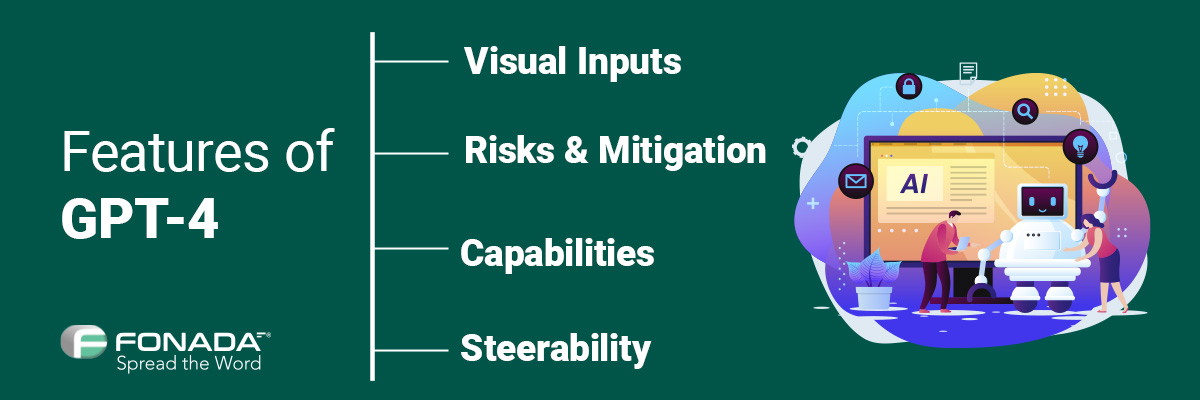
1. Visual Inputs
It can work with both text and images as prompts, giving users more options and letting them choose any language or vision task.
Image inputs remain in the research preview stage and are not yet accessible to the general public.
2. Risks & Mitigation
GPT-4 is safer and more secure than its predecessors for mitigating and filtering unwanted guidance, unstable code, and inaccurate data.
GPT-4 is safer and more coordinated due to pretraining data selection and filtering, evaluations and expert participation, model safety systems, and enforcement and tracking.
3. Capabilities:
The capabilities of the GPT-4 are an upgrade over those of its predecessor, the GPT-3.5, particularly in terms of consistency, creativity, and the ability to handle instructions with delicacy.
GPT-4 surpassed large language models on OpenAI benchmarks, including human-simulated tests. It also works well in languages besides English, especially those with limited resources, including Latvian and Swahili.
4. Steerability:
OpenAI added more controls to the GPT architecture with the release of GPT-4. Developers and clients can customize the AI’s personality and tasks through system messages.
Read More: Top 10 Best Virtual Phone Number Providers In India
Examples of Enterprise Applications Using GPT-4
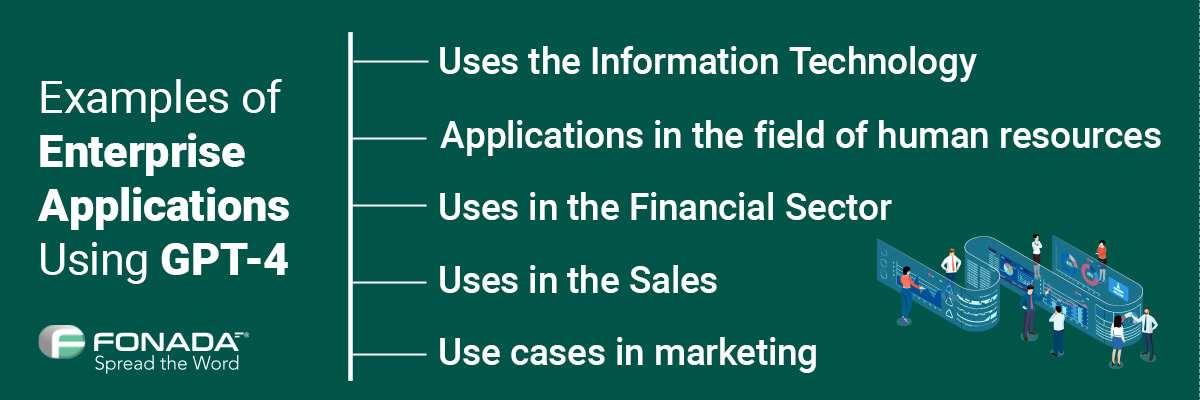
GPT-4 is an advancement of GPT-3, which has applications in various areas, including natural language processing (NLP), translation software, voice recognition, and understanding. GPT-4 can also be used in these areas. It can also be used for tasks like summarizing or understanding that require a deep understanding of the text. The increased capabilities of the GPT-4 have major effects on various business industries and application areas. GPT-4 is suitable for assistance, selling, content moderation, and coding due to its capacity to handle more complicated and nuanced instructions.
The following are some of the ways that GPT-4 can help different teams within the organization today:
1. Uses the Information Technology:
- Provide a solution for how to fix an image of a damaged piece of hardware.
- Informational articles could be generated automatically as needed.
- Generate a concise summary of fully detailed or long support tickets.
2. Applications In The Field Of Human Resources:
- Summarize performance reviews and pull out the most vital aspects
- Automate Open Enrollment internal communications.
- Develop customized onboarding programs for specific departments and roles.
3. Uses in the Financial Sector:
- Assist vendors and suppliers in drafting negotiation letters
- Improving financial analysis through automated data entry
- Convert image-based vendor agreements to text
4. Uses in the Sales:
- Generate outreach for various personas automatically.
- Create a quote photo in their billing platform’s preferred format.
- Summarize and communicate concisely technical topics
5. Use Cases In Marketing:
- Draw images to use as a basis for creating slides or visuals.
- Copywrite for email and advertising campaigns
- Make landing page mock-ups from hand-drawn notes
GPT-4 Vs. The GPT-3.5: What is the Difference ?
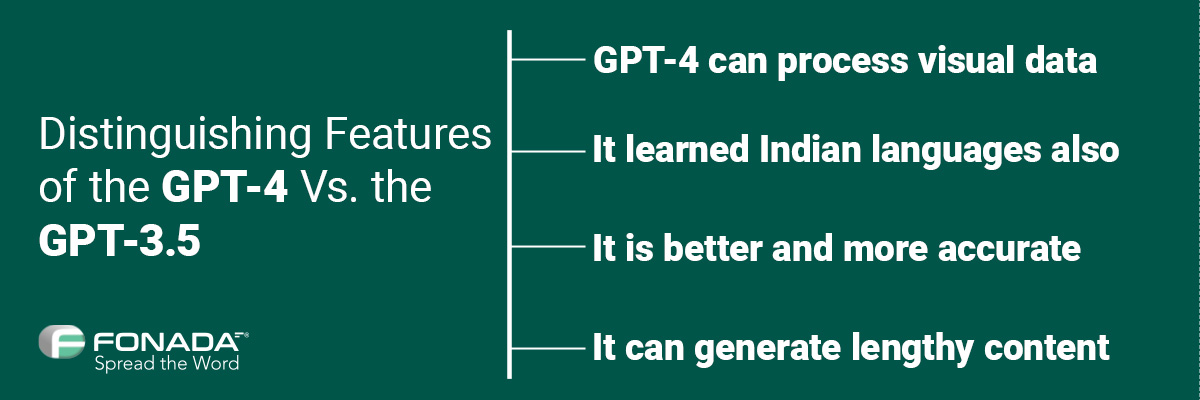
1. GPT-4 Can Process Visual Data
The ability of GPT-4 to understand images is the primary and most significant improvement that it brings. To put it more plainly, GPT-4 enables ChatGPT to comprehend images in addition to text inputs, upload an image to its search field, and ask ChatGPT to interpret the image in various ways.
The GPT-4 chatbot remarked that having a VGA cable with a current smartphone was impractical. Users will still only receive text outputs from GPT-4, but they will be allowed to include images in their queries, and the system will understand those images.
2. It Learned Indian Languages
On the OpenAI research page, the business stated that out of the 26 different languages from around the world that were used to test GPT-4, there were five Indian languages. These languages included Bengali, Urdu, Punjabi, Marathi, and Telugu. This could indicate that GPT-4-powered bots like ChatGPT Plus could soon answer local language questions.
The use of Azure Translate suggests that GPT-4 only understands English, but queries can be translated in both directions to process inputs in a user’s local languages.
3. It Is Better And More Accurate
ChatGPT’s GPT-3.5 served as the basis for GPT-4’s training, although GPT-4 has been trained on much more data. It is estimated that GPT-4 will need almost 3 trillion data points, more than 17 times as much data as GPT-3.5’s total of 175 billion parameters.
So, your queries will be addressed more accurately, quickly, and thoroughly.
4. It Can Generate Lengthy Content
One important thing that GPT-4 can do is store more information in a single query.
One GPT-4 query will consume 32,768 memory tokens, up from 4,096 in ChatGPT (GPT-3.5). This means that GPT-4 can process 8 times more information whenever a user questions.
Read More: Top 10 Most Popular Bulk SMS Service Providers In India
Does GPT-4 Replace ChatGPT?
Whether or not GPT-4 would replace ChatGPT would depend on the goals and decisions of the organization behind its development. Typically, new versions of AI models can coexist with previous ones, and their adoption depends on factors like performance, cost, and specific use cases. It’s possible that a newer model like GPT-4 could be used to enhance or replace ChatGPT in certain applications, but it would ultimately depend on the strategies and plans of the organization utilizing these technologies.
OpenAI was developed and made available to the public ChatGPT, an AI chatbot, and platform, in November. The tool is how users can experience different versions of GPTs. This means that ChatGPT will remain the same, but the logic behind it will change.
ChatGPT was initially driven by GPT-3.5, the most advanced language model. It employed numerous data points to analyze a user’s writing and provide human-like responses according to its expertise.
The GPT-4 theory is the same as the previous one but with several improvements. Because of this, the next iteration of ChatGPT will run on the GPT-4 platform.
Frequently Asked Questions
1. What Is Chatgpt Version 4?
The abbreviation GPT-4 refers to the Generative Pre-trained Transformer 4. GPT-4 is an advanced AI model that builds on the foundation established by ChatGPT. GPT-4 is “multimodal,” meaning it can make content from text and images.
2. How To Use ChatGPT 4?
Signing up for GPT-4 through OpenAI will allow you to gain access to it.
- To gain access to GPT-4, use this OpenAI URL in your web browser.
- To sign up, you will need to finish all the steps.
- When you’re done, you’ll be in the OpenAI Dashboard.
3. What Is New In Chatgpt Version 4?
GPT-4 is a pre-trained system, and this means it has been developed on a great deal of text and may be used more accurately for language processing techniques.
One of the most powerful language models, OpenAI’s latest GPT series uses machine learning to generate human-like texts.
4. Do You Have Access To ChatGPT 4?
GPT-4 can handle text and image data sources, but ChatGPT Plus subscriptions and software developers can only use the text-input feature. The image-input feature has yet to be available to the public.
5. What Makes GPT-4 Unique?
GPT-4 improves model “alignment”—the capacity to follow user intentions—while making it more true and less offensive or harmful. The GPT model now has multimodal functionality due to GPT-4, the other significant difference between the two versions. Specifying a task with text and graphics allows users to specify any visual or language job.
